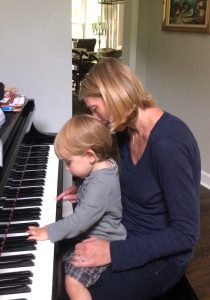 Stack Them
Stack Them
STEM Concepts: Science (physical science) Math (number sense and operations, measurement), Engineering (engineering)
Materials: A variety of plastic storage containers and their lids.
What to do: Have your child use these containers to match the lids with the correct container and then stack them to build different towers.
Language and Communication: Use directional vocabulary like: on top, on bottom, next to, and underneath. Encourage them to knock them down and start over. When they knock them over say things like, “That’s okay, let’s make a bigger tower or a smaller tower.”
Expand the Activity: Use your containers and other household items to stack and see if they can make towers taller than other objects in the house. For example, themselves, tables, couches, or chairs.
Music
STEM Concepts: Science (physical science, life science), Math (patterns, spatial relationships)
Materials: Pots and pans, wooden spoons, musical instruments if available, bottles filled with rice (Be sure they are sealed tight.)
What to do: Have your child beat on the different surfaces. Let them explore the different sounds and vibrations the different surfaces create.
Language and Communication: Use vocabulary words: loud, quiet, squeaky, vibrating, and sound when talking to your child about the sounds they are making. Describe what you hear and ask them what they hear or feel!
Expand the Activity: Make sounds using your body. Tapping on something or making noises by clapping hands or stomping feet. You can also include making sounds with their mouths. Model these sounds while continuing the use of the vocabulary above.
Plastic Animals
STEM Concepts: Science (physical science, life science and earth science), Math (number sense and operations, classification)
Materials: A variety of plastic animals
What to do: This is the easiest and most simple activity you can do with your child. Have them play with the animals while exploring their features with you. Point out similarities and differences, count legs, and put them in categories such as all animals with two lets and all animals with four legs.
Language and Communication: Tell your child the name of the animals, what noises they make and what they eat. Talk about where they live and what weather they like. Talk about who takes care of the animals or if they live in the wild. Make references to things your child may know from the area they live.
Expand the Activity: Compare the animals shapes and sizes or by what they eat and where they live.
Create small environments with pictures or items around your home.
Count the animals with your child to add another math concept to their play.

